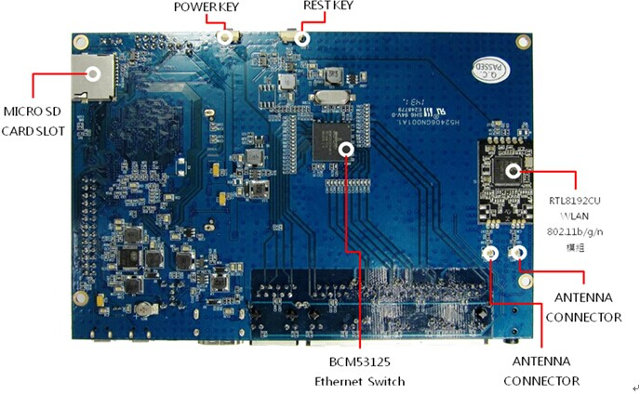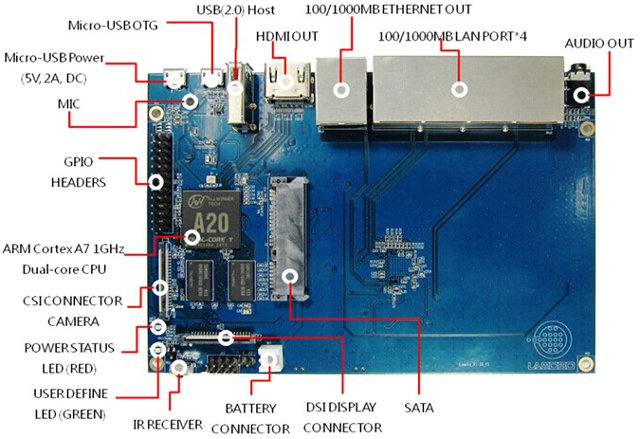SinoVoIP, a company known for its Banana Pi board and related spamming, has been working on another AllWinner A20 product called BPI-R1 (Banana Pi R1), a router/NAS platform that features 5 Gigabit Ethernet ports, a SATA interface, HDMI, audio output, and more.
- SoC- Allwinner A20 dual core Cortex A7 processor @ 1 GHz with Mali-400MP2 GPU
- System Memory – 1 GB DDR3
- Storage – SD card slot up to 64GB, SATA connector for hard drive or SSD up to 2TB
- Video output – HDMI, LVDS/RGB via DSI connectors
- Audio I/O – HDMI, 3.5mm stereo jack, and on-board microphone
- Camera – CSI connector possibly interfacing with their upcoming BPI-D1 camera
- Connectivity – 5x Gigabit Ethernet (RJ45) ports including 4x LAN ports, 1x WAN port, 802.11 b/g/n Wi-Fi (RTL8192CU module) with two antenna connectors.
- USB – 1x USB 2.0 port, 1x micro USB OTG port, 1x micro USB for power
- I/O Expansion Headers:
- 26-pin header (but not fully R-Pi compatible) with access to GPIO, UART, I2C, SPI, CAN, PWM, 3.3V, 5V and GND pins
- 8-pin header with UART7, 2 more GPIOs, and power signals
- 2-pin header for UART0 Tx and Rx.
- Misc – Power and reset buttons, Power and user LEDs, IR receiver, Battery connector
- Dimensions – 148 x 100 mm
- Weight – 83 grams
The company will provide Linux and Android 4.2.2 images and source code for the board. They also claim BPI-R1 is an “open source router”, but based on their previous products, that only includes the software, not the hardware.
 The board is expected to be available in October 2014 for $65. OS Images should eventually become available in the Download section of Bananapi.com, and source code in their github account. Further details may be available on SinoVoIP BRI-R1 product page.
The board is expected to be available in October 2014 for $65. OS Images should eventually become available in the Download section of Bananapi.com, and source code in their github account. Further details may be available on SinoVoIP BRI-R1 product page.
Thank you Lalith!

Jean-Luc started CNX Software in 2010 as a part-time endeavor, before quitting his job as a software engineering manager, and starting to write daily news, and reviews full time later in 2011.
Support CNX Software! Donate via cryptocurrencies, become a Patron on Patreon, or purchase goods on Amazon or Aliexpress





